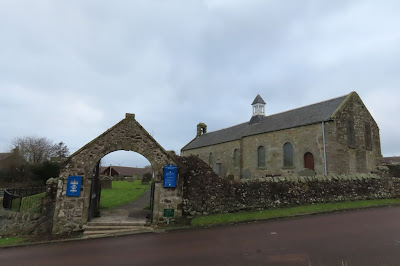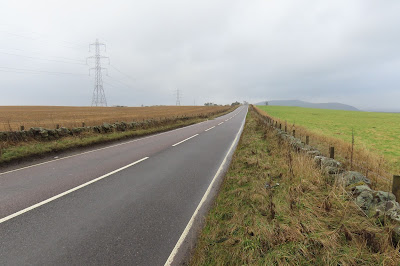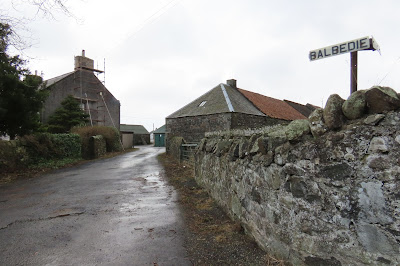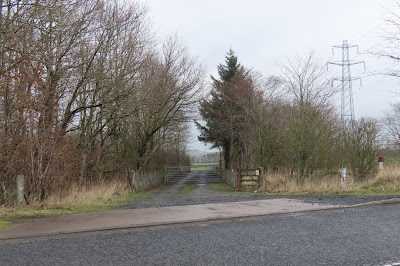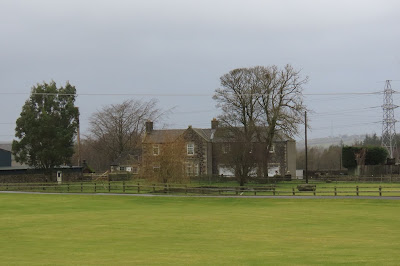Benchmark, gatepost, Craigie Roadside Cottages - NO 4524
For the next short bit along the road, I was dodging horses and cars and looking ahead to see if I could see the trigpoint. It had been a long time since I'd done a new trigpoint and I was quite excited about it. Perhaps I'd be able to have my first stop there as I hadn't seen anywhere suitable to sit down yet - and I have a musing that one has to sit down if one is partaking of food or drink (although I have once or twice broken my own rule and my brother breaks it all the time).
Once in NO 4424, I looked briefly for a benchmark which I fear may have been destroyed along with the ruinous wall that runs alongside the B945. It was too dangerous to stand by the side of the road stamping down vegetation, so I gave up after just a couple of minutes and decided to fight my way up the steep hill towards the trigpoint rather than follow the obvious path.
After about five minutes of slipping and grabbing tree trunks, I emerged at a barbed wire fence, beyond which had a familiar look about it. Was this a country estate? I found a part of the fence with no barbed wire and hopped across it onto, no, not a country estate but a golf course! Wretched thing! Why put a golf course around a trigpoint or put a trigpoint in a golf course (not sure which came first). Closely following my memory map for navigation, I waited for a group of golfers to tee off before walking boldly in the direction of the trigpoint, only to find it wasn't in that direction. I changed tack and continued south-westerly to another clump of bushes which I reckoned might be hiding the trig. I wasn't about to give up now, no matter how hard the golfers stared!
But there's only so much feeling uncomfortable you can put up with and I'd reached my limit. I sneaked back down from the bushes to where I considered a safe distance from the course and pulled out my sitting mat, flask and biscuit. Feeling disappointed that the trig had disappeared I remembered another occasion when I had felt exactly the same. And what had happened? I'd gone back home and realised I'd missed the trig by a matter of a few feet!
Hearing golfers' voices above me, I cowered down and pulled out my phone to log into the Trigpointing UK website, where I saw photos of an unobscured 'easily accessed' trigpoint right here. But where? I asked myself aloud.
Right, that does it. I'm not leaving here until I find it, I resolved and got up and continued walking. How could I miss a near four foot of concrete? I came round the corner and there it was! At the junction of two paths. Quickly I snapped the requisite photos and made a hasty retreat. if I never saw another golf course, it would be too soon.
Craigie Hill trigpoint - NO 4424
I didn't like the thought of going back the way I had come, but the alternative was to nose dive off a very steep cliff onto the road and walk back along the busy road, which was an even less appealing prospect. So I grinned and beared it, making as much haste as I could and soon found myself back at the entrance to the Tentsmuir Road. This was the only bit of my walk today which wasn't strictly speaking circular, but I'd made the detour in order to bag the trigpoint.
I walked back to Craigie Farm, where I took a right turn past Red Row Cottages and into my next gridsquare, NO 4423. For a minute it looked like I was wandering into someone's garden, but the path opened up and entered St Michael's Wood, where I felt sure I would find somewhere to eat my lunch.
St Michael's Wood - NO 4423My desire for tranquility after the golf course was thwarted by the felling of trees I could hear to my right. Same as I'd heard at Rhynd Wood earlier (and forgot to mention, but important for the title of this post). Not wanting to sit with that noise in my ears, I plodded on, hearing and seeing little. I emerged back on the B945 I'd crossed earlier and immediately started looking for the next benchmark. Ah, there it was on the wall of a house - The Hermitage.
Benchmark on Hermitage, St Michael's - NO 4422
Hermitage, St Michael's - NO 4422
This was another road I had driven along many times and I had eaten in the pub, St Michael's Inn on once unforgettable occasion when we were doing a 24 hour Fife Bird Race. Little did I know then that the pub boasts a flush bracket. My second of the day. All I had to do was cross this crazily busy road to get to it and then work out which way to go next.
St Michael's Inn - NO 4422
I had all but given up on finding this flush bracket when I resorted once more to my trusty website where I was informed it was on the north-west face of the building. A quick reckoning told me this was the right hand side (in above photo) and lo and behold there partially hidden by wooden fence you can see in the photo, was a heavily painted flush bracket.
Flush bracket, St Michael's Inn - NO 4424
I was tempted to go and buy one of those hot air paint strippers to allow the poor flush bracket to breathe again but thought that might actually cause more damage than good, so had to wish it well and leave it suffocating and under-appreciated at this busy road junction.
I was heading south, under a railway bridge where I looked for another benchmark, but couldn't see it and felt too conspicuous and unsafe clearing vegetation to look more earnestly for it. I was also conscious that I was on an even busier A road and that the pavement I was walking on couldn't possibly last much longer. I was right; it lasted as far as Burnside house and then petered out. There was a footpath sign, however to the left heading for Leuchars via 'The Coffin Road', which sounded intriguing. If I took that path, I would avoid having to walk along the A road, but I would also miss out on a further two gridsquares.
It was a no brainer really. I opted for the footpath. I'd have to work in the other two squares some other time. I walked through woodland and uphill to another distressingly familiar sight - another &&**"" golf course! How many of them are there here? Can't you walk anywhere without risking being massacred by chain saws or hit on the head by a stray golf ball or treading in mounds of disgusting dog dirt? Annoyed I puffed and panted my way along the edge of the course, desperately searching for the footpath signs. It had clearly said this was the footpath to Leuchars, so where was the next sign?
I ended up asking a couple of players who pointed me in the right/wrong direction. "You see that yellow flag there?" One of them asked, pointing to a bright yellow flag that was just being uprooted from its lodging. "About opposite that flag there's the footpath, which will take you down the hill."
Relieved, I quickly crossed the golf course and walked along some rough ground towards the yellow flag which was being repositioned by two more players who seemed to take ages to tee off to the next hole. Was it because they could see me lurking in the bushes to their right? Feeling distinctly uncomfortable for the second time that day, I patiently waited for them to 'just go' (muttering inaudibly to myself). After an age of practicing, they finally got the ball off the tee and walked, very slowly, on. They definitely knew I was there! I ran across the course again to where I could see a small stile. A man with an Alsatian was walking brazenly towards me with no apparent concern that he too was on a golf course. Finally, I was at the stile where I paused to take a photo, which, under normal circumstances, I would never bother with. Then I nipped over the stile into freedom and peace, at last!
Gallow Hill Golf Course on a thankfully quiet day - NO 4421
But something wasn't quite right, this was not the direction I wanted to go. This was the direction I had just walked from! I had to cross that **$$$££** golf course again. There was absolutely no signage to help, so I trotted across the golf course, trying to remain incognito with my camera, binocs and huge rucksack to where I could see the CH (Clubhouse) and a thousand cars. And a cemetery. At last! Somewhere I could eat my lunch in peace.
Rarely have I felt more relieved to walk through gates. My relief was short-lived, however and I'll tell you why in a minute.
For now I can draw breath again, I will tell you about the Coffin Road in case you're not familiar with the concept. Interestingly the golf course I had crossed was on Gallow Hill, presumably the historic place of execution for the town of Leuchars. Aside from that, the route I had just taken (without the detours) was once the route used to carry the dead in their coffins to the cemetery. There is a beautiful description of this rite
here.
Once inside the gates of the cemetery I placed my mat on the first bench and got out my flask and lunch. There were only two other people in the cemetery who seemed to be doing some strimming as there was a rather irritating noise coming from their direction. The noise continued after they had left, however. It was rather like a mosquito buzzing round your ear. After lunch, I quickly walked round the cemetery in search of any interesting graves. One in particular stood out, dedicated to a 'stargazer'.
Stargazer's grave, Leuchars Cemetery - NO 4421
The dragon engraving and quote at the bottom also caught my eye. "It simply isn't an adventure worth telling if there aren't any dragons." The first time I'd ever seen a dragon on a grave! When I got home, I did some research and discovered this quote, which is usually attributed to J R R Tolkien, is in fact from a book called Simple Abundance by Sarah Ban Breathnach. Although not a great fan of dragons, per se, I rather like the notion behind this quote - that you've got to have adventure in your life to spice it up a bit or, as Tolkien does advise, “It does not do to leave a live dragon out of your calculations, if you live near him.”
I certainly felt as if I had met one of my dragons today and I could still hear it breathing loudly somewhere not too far away. As I left the graveyard, I made my way up to the war memorial where the mosquito noise was reaching screaming pitch.
War Memorial, Leuchars - NO 4421
Then I discovered the source of the noise. Scramble bikes. Another thing I fail to see the attraction of. I found the noise unbearable and the sight of machines tearing up the countryside always disturbs me. Yes I know it's better to have a designated place for such activities to stop them using any and every available corner of earth to disturb the peace, but it's a bit like dog mess. Designated places or not, there will always be those who choose not to use those designated places.
You can tell how much I enjoyed today's walk, can't you!? I tore down the hill as fast as I dared, using the field next to the scramble bike field for obvious reasons. I was heading unavoidably towards about 20 large vehicles (large enough to carry the bikes). I felt uncomfortable for the third time that day. The noise went right through me, loud and screeching and coming from all directions as the bike trials were being held in more than one field. It was horrendous.
I walked south towards Leuchars station and into the next grid square - just, before turning sharply north-eastwards on a track back to Leuchars, with the sound of the bikes ringing in my ears.
Leuchars train station - NO4420
I had completed my gridsquares and done a full circle back to Leuchars. Walking under the railway bridge, I re-entered the village where I took a deliberate detour to bag another flush bracket, my third of the day, this time on a former masonic lodge.
Former masonic lodge, Leuchars - NO 4521
Flush bracket on masonic lodge, Leuchars - NO 4521
I hadn't forgotten about my vow to return to the other two benchmarks, the ones I'd decided to leave till the end of my walk. I wandered up to St Athernase Church and sat on the bench with my final cup of tea of the day. Circumnavigating the church, I finally found the bolt benchmark and then another on a nearby cottage.
Benchmark, #2 Main Street, Leuchars - NO 4521
Bolt benchmark, St Athernase Church, Leuchars - NO 4521
I was relieved to get back inside my car - away from bikes, chain saws and golf balls. I think with all confidence I can say that I will never repeat this walk, but I did see the following in recompense for my trouble:
Number of new gridsquares: 11
Number of anticipated new gridsquares: 13
Number of trigpoints: 1
Number of benchmarks: 6 (3 FBs, 1 bolt, 2 cut marks)
Number of anticipated benchmarks: 9
Number of golf courses: 2
Number of nosey parkers: 1
Walk worth repeating: Definitely not
Highlights: Erm, the Stargazer's grave, Leuchars


